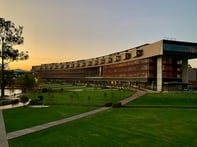Published on
Supporting Rural and Local Communities in Higher Ed

To properly serve learner needs, especially in rural or Indigenous communities, a community approach that considers individual needs and goals is critical.
Rural communities are dependent on higher education to thrive and fuel the economy. But education isn’t always as accessible in these remote areas, and learners are often challenged with obstacles in their day-to-day lives that prevent them from pursuing education. Higher ed therefore has an opportunity to support these communities. In this interview, Sydney Goodfellow and Ryan Oliver discuss the importance of workforce development programs and meeting the needs of members of rural and local communities.
The EvoLLLution (Evo): Why is it important for higher ed to put more concentrated efforts behind their workforce development programs, especially when it comes to rural and local communities?
Sydney Goodfellow (SG): There’s a particularly major role for postsecondary and higher ed institutions to play in rural and remote communities. Oftentimes, they’re the only institution in the community, so they can become the conduit for so many different conversations around workforce development.
When people talk about economic and workforce development, the first place they often look to is the higher ed institution rooted in the community. It’s a two-sided coin. They play an important role in the community and are well positioned to support the community and workforce in whatever transition is happening.
Ryan Oliver (RO): Especially in remote and Indigenous communities where there are higher ed opportunities, they often exist outside the accredited world. In Nunavut, for example, there’s the Nunavut Arctic College, which technically has a location in 25 communities across Nunavut. But the reality is that it’s often some combination of the not-for-profits, the Arctic College and other organizations on the ground that know specifically what that community needs.
When they leverage supports, they can do so for that community. It’s not a one-size-fits-all approach. We have to ensure that, for every community we go into and work in, the curriculum and the way we approach that community is specific to their needs. In a similar way, education of all types will best serve a community when it is from that community. That’s where you can get the best results.
Evo: What are some challenges within these rural and local communities when it comes to accessing education or workforce development programming?
SG: It’s about thinking about workforce development versus more academic programs. With the pace of change in technology, a four-year or two-year program is not able to keep up. So, more educational institutions are looking at shorter cycle training and partnerships with organizations that deliver short cycle training.
Those on-the-ground relationships with organizations that understand the dynamics of delivery and have programs keeping up with that pace of change are critical. Some things we hear from communities that we work with is the importance of connectivity. That infrastructure piece is changing in time, but that’s a big one to ensuring learning is accessible to all participants.
RO: Looking at the hierarchy of needs, we haven’t solved the issues around basic needs in most remote and Indigenous communities—issues like housing, water, quality of life and wage concerns. So, helping people like the government and funders understand what you need to pay someone in these communities compared to in the south is critical. They need to see the value and impact of where that money goes. We’re not overpaying people to stay at their job; it’s just how much it costs to survive because the cost of living is so high.
There’s also a lack of workforce development in these communities. In the north, there aren’t many options to get this education. On top of that, there’s a challenge with housing when you hire someone, then their wage. Essentially, if you want to hire someone away from their job and can’t provide housing, then they’re close to becoming homeless. As an organization, you have to think more holistically.
Evo: How can partnerships between higher ed and the local community help overcome some of these obstacles?
SG: Pure training isn’t enough. When we talk about a seat in a school, it’s one small part of the equation. Thinking about someone’s entire educational life cycle and all the other wraparounds that a person might need in order to be successful is critical to focus on. Not all institutions may be thinking about this, but they should. Community integration can really help someone progress through their educational journey. That can only happen effectively through partnerships because you need to leverage each other’s expertise.
Another element people look at as a key metric of success is the number of people being trained, as well as the cost per participant or learner economics. It’s also going to be more expensive in rural places, so partnerships can help ensure each individual pays slightly less to sum up to something much greater than its individual parts. Beyond that, we also need a greater understanding around the true financial cost of working in rural communities and be willing to look differently at the unit like the unit economics of working in workforce development.
RO: I’ll often say to our funders that other players in this space will give you three million learners, and I’ll give you three thousand and I also need more money. But what I’ll be able to do is tell you the story of every single person we work with. I can tell you where they came from and why this had a huge impact. We’re not going to just work with them for ten minutes. We’re going to work with them for ten weeks, and I can show that impact.
Good partnerships know where the strengths and weaknesses are and can come together to ultimately become one big wall of strength. That’s a key part of it, and ultimately the community has to be at that table for it to happen.
Evo: What are the characteristics of a strong partnership?
SG: There are many transactional approaches that people take. Looking for partners who are committed and in it for the long run is going to be impactful. In smaller communities, there’s a fatigue of people coming in and extracting information or their own value, then leaving when they have what they need.
As an organization built on collaboration, it’s really about the people. It takes a couple of dedicated people, and a team dynamic emerges that leads to strong collaboration. There’s a Swiss cheese method of risks. You have to ensure you’re layering complimentary areas of expertise to meet the full spectrum of a learner’s experience.
RO: For us, the strongest partnerships are the ones that last beyond the single project. We have a life cycle that we try and utilize in every case. Often when I’m working with any new partner, I’ll say this is a 20-plus-year commitment that we’re making. It isn’t going to be the length of this grant or project, it’s going to go beyond that. So, having shared values is key.
That’s easier said than done. As Sydney mentioned, many people go in and out of communities that people glaze over. But you need someone to vouch for you, someone that has built the trust in a community to be able to bring this group in. That happened for us with Google, who was in the distance but one day came here because we had the space where they could run their programming. So, this was a partnership that had shared values and good communication.
Evo: How has the partnership between DIGITAL and Pinnguaq helped communities in need?
SG: For DIGITAL, we’re founded on principles of collaboration and collaborative innovation. We think about public, private, nonprofit partnerships and what can happen if we bring these different parties to the same table to focus on shared goals and shared challenges. That’s something that’s been part of our DNA. Our approach to collaboration lies in seeing ourselves as a catalyst. So, we are not working in those communities, but we’re actively seeking partners who are, who have that experience and who can then catalyze the work. We listen to what it means to work in rural communities and the cost-related pieces to factor those into the program design.
We navigate that bridge, and the work we are enabling is impactful—we’re not incentivizing more transactional approaches. In designing our programs, we try to be very intentional about whom we were working with and how those partnerships are developed. We actively listen to partners and communities on what a successful program would look like. Pinnguaq has been integral in helping with design and standup, as have other partners we’ve worked with. It’s been a long-term, very intentional approach of listening actively to folks who’ve worked in this space for a long time, so we can design programs where we’re incentivizing the right things.
Evo: What are some trends you expect to see when it comes to workforce development and partnerships within the rural communities?
SG: What we’re hearing and seeing are more tailored approaches. Rather than thinking about a community needing a certain number of people, more institutions, training providers and workforce development agencies are looking at directly integrating with the specific goals that community has for its growth, specific challenges it is trying to address or specific industrial sectors that are growing or that the community is looking to attract. So, rather than a general program that everybody can run through, this is a tailored program that’s unique to this community and that we are uniquely positioned in this community to deliver because this is what we want.
Rather than trying to figure out an overall curriculum that would serve all these needs in a length of time, it’s about periodically introducing people to concepts throughout their career to navigate the pace of change. We see it often in the context of microcredentials, but they’re part of a broader move toward more rapid, adaptable and transferable training. That’s something remote and rural communities have been doing for a very long time in a way others can learn from. There’s a more collaborative approach because of this pace of change.
RO: The community-centered approach has been a big thing for us for a long time, but we’re getting smarter about how we do this. Everyone is realizing that the one-size-fits-all approach isn’t a useful way to get data that will make an impact. The challenge is the funders and specifically building an understanding that the long-term investment is worth it. I know the numbers aren’t going to be flashy, but the long-term investment is worth it. The ultimate goal is to create this life cycle of serving a community.



